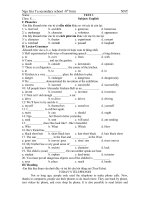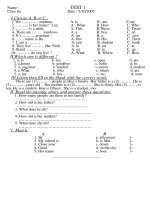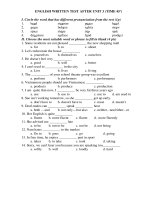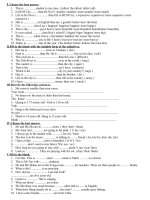Physics section test (1)
Bạn đang xem bản rút gọn của tài liệu. Xem và tải ngay bản đầy đủ của tài liệu tại đây (1.07 MB, 11 trang )
MCAT Section Tests
Dear Future Doctor,
The following Section Test and explanations should be used to practice and to assess
your mastery of critical thinking in each of the section areas. Topics are confluent and
are not necessarily in any specific order or fixed proportion. This is the level of
integration in your preparation that collects what you have learned in the Kaplan
classroom and synthesizes your knowledge with your critical thinking.
Simply
completing the tests is inadequate; a solid understanding of your performance through
your Score Reports and the explanations is necessary to diagnose your specific
weaknesses and address them before Test Day.
All rights are reserved pursuant to the copyright laws and the contract clause in your
enrollment agreement and as printed below. Misdemeanor and felony infractions can
severely limit your ability to be accepted to a medical program and a conviction can
result in the removal of a medical license. We offer this material for your practice in your
own home as a courtesy and privilege. Practice today so that you can perform on test
day; this material was designed to give you every advantage on the MCAT and we wish
you the best of luck in your preparation.
Sincerely,
Albert Chen
Executive Director, Pre-Health Research and Development
Kaplan Test Prep
© 2003 Kaplan, Inc.
All rights reserved. No part of this book may be reproduced in any form, by Photostat, microfilm,
xerography or any other means, or incorporated into any information retrieval system, electronic
or mechanical without the written permission of Kaplan, Inc. This book may not be duplicated,
distributed or resold, pursuant to the terms of your Kaplan Enrollment Agreement.
Physical Sciences
Test 1
Time: 40 Minutes
Number of Questions: 31
MCAT
PHYSICAL SCIENCES
DIRECTIONS: Most of the questions in the
following Physical Sciences test are organized
into groups, with a descriptive passage
preceding each group of questions. Study the
passage, then select the single best answer to
each question in the group. Some of the
questions are not based on a descriptive
passage; you must also select the best answer to
these questions. If you are unsure of the best
answer, eliminate the choices that you know are
incorrect, then select an answer from the
choices that remain. Indicate your selection by
blackening the corresponding circle on your
answer sheet. A periodic table is provided
below for your use with the questions.
PERIODIC TABLE OF THE ELEMENTS
GO ON TO THE NEXT PAGE.
2
as developed by
Physical Sciences 1
Passage I (Questions 1–8)
1.
Malachite is a green semiprecious stone with the
molecular formula CuCO3 • Cu(OH)2. Malachite is
widespread in nature, occurring near copper deposits,
and can also be synthesized in the laboratory.
Three experiments were carried out to investigate
some of the chemical properties of malachite. In each
experiment, evolved gases were collected in the
following apparatus: a rubber tube was connected at one
end to a reaction vessel; the free end of the tube was
inserted into collection bottles inverted in a tub of
water, allowing gas to displace the water in the bottle.
The bottles were corked and set aside for later analysis.
A.
B.
C.
D.
2.
3.
A 44 g sample of malachite was placed in the
reaction vessel, and an aqueous sulfuric acid solution
was added to the vessel. Shortly, gas evolved from the
free end of the tube. When the reaction was complete, a
strip of pH paper inserted into the aqueous solution in
the reaction vessel showed it to be neutral.
4.
Experiment 3
Three gas-filled collection bottles were taken from
each of the above experiments. A burning splint was
inserted into the mouth of one bottle from each
experiment; in each case, the flame was extinguished
immediately. Water, 25 mL, was then added to the
second bottle from each experiment, and the bottle was
corked and shaken. Strips of pH paper dipped in the
water turned pink in both cases. Finally, 50 mL of
calcium hydroxide solution were added to the third
bottle from each experiment, and the bottles were
shaken. A milky white solution was observed in each.
29%
36%
50%
67%
The reaction that occurred in Experiment 1 can be
classified as a(n):
A.
B.
C.
D.
Experiment 2
oxygen.
water vapor.
carbon dioxide.
hydrogen.
What is the percent composition of oxygen in
malachite?
A.
B.
C.
D.
The following experiments were performed:
Experiment 1
A 22 g sample of malachite was placed in the
reaction vessel and the bottom of the vessel was heated
rapidly. After a short time, a black solid appeared in the
bottom of the reaction vessel, condensation appeared on
the flask, and gas bubbled through the free end of the
tube into the collecting bottles. The black solid was
identified as copper (II) oxide.
The gas collected in Experiments 1 and 2 was most
likely:
acid-base reaction.
double displacement reaction.
redox reaction.
decomposition reaction.
Assume the gas collected in Experiment 1 is pure. If
the volume of each collection bottle is 100 mL,
how many bottles will be needed to collect all the
gas produced? (The conditions are STP.)
A. 2 vessels
B. 3 vessels
C. 22 vessels
D. 23 vessels
5.
Which of the following statements is true of
Experiment 2?
A. An excess of sulfuric acid was added to the
reaction vessel.
B. An aqueous copper sulfate solution was
formed.
C. An aqueous copper hydroxide solution was
formed.
D. The pH paper turned blue upon contact with the
reaction solution.
GO ON TO THE NEXT PAGE.
KAPLAN
3
MCAT
6.
If stoichiometric amounts of calcium hydroxide
solution were used in Experiment 3, the final
solution would be:
A.
B.
C.
D.
7.
If Experiment 2 were performed with aqueous
hydrochloric acid rather than sulfuric acid, you
would expect the products to be:
A.
B.
C.
D.
8.
neutral.
acidic.
basic.
Cannot be determined
Cu(s), Cl2(g), CO2(g), H2O
CuCl2(aq), H2O, CO2(g)
HCl(aq), H2CO3(aq), H2O
CuCl2(aq), Cu(s), H2CO3(aq)
When the copper oxide produced in Experiment 1
was weighed, it was found that 4 g had been
produced. What was the percent yield of copper
oxide from this experiment?
A. 18%
B. 25%
C. 50%
D. 100%
Passage II (Questions 9–13)
There are situations in which matter may be
converted into energy. This occurs, for example, in the
formation of a nucleus, the mass of which is found to be
slightly less than the sum of the masses of the individual
protons and neutrons. Another instance in which this
occurs is in the process of nuclear fusion, which
describes the reaction when two smaller nuclei are
brought together under certain conditions and join
together to form a larger nucleus, resulting in the release
of large amounts of energy. In the sun’s core, for
example, 2 hydrogen atoms combine to form one helium
atom. By this process the sun produces 4 x 1026 J of
energy every second.
Energy can be released not only by fusing smaller
nuclei but by splitting larger ones. This process is known
as nuclear fission. For example, when uranium is
bombarded with neutrons, it is split into two smaller
nuclei and energy is released. This particular nuclear
reaction also releases more neutrons, which can cause
further fission reactions with other uranium nuclei and
thus lead to a self-sustaining chain reaction. In nuclear
reactors, this process is controlled by inserting control
rods, made of elements such as cadmium, that absorb
some of the neutrons without undergoing a fission
reaction themselves.
9.
A typical uranium fission reaction is shown below.
235
92
1
U + 10 n→ 139
54 Xe + Y + 30 n
What is the product Y formed by this reaction?
A.
94
36
Kr
B.
92
38
Sr
C.
94
38
Sr
D.
139
54
Xe
GO ON TO THE NEXT PAGE.
4
as developed by
Physical Sciences 1
10. The total energy that it takes to separate a nucleus
into its individual protons and neutrons is called the
binding energy. This energy:
A. is sufficient to sustain a chain reaction.
B. is equal to the total mass of the nucleus times
the speed of light squared.
C. is equal to the mass defect of the nucleus times
the speed of light squared.
D. is equal to the kinetic energy of a β – particle
ejected during beta decay.
13. Fission reactions can be initiated by bombarding
nuclei with neutrons. Would bombarding with
protons work just as well?
A. Yes, because protons and neutrons are both
present in the nucleus.
B. Yes, because protons and neutrons have
approximately the same mass.
C. No, because protons do not have as high a
binding energy as neutrons and thus not as
energetic.
D. No, because neutrons, unlike protons, do not
experience electrostatic repulsion from the
nucleus.
11. The neutrons that are released during a fission
reaction are first passed through a magnetic field,
and then through an electric field. They are:
A. deflected by the magnetic field only.
B. deflected by the electric field only.
C. deflected by both the magnetic field and the
electric field.
D. not deflected at all.
12.
90
38
Srdecays by emitting an alpha particle to form a
86
stable isotope of krypton, 36 Kr . If after 19 hours
75% of the sample has decayed, what is the half life
of the reaction?
A. 4.8 hours
B. 9.5 hours
C. 14 hours
D. 29 hours
GO ON TO THE NEXT PAGE.
KAPLAN
5
MCAT
Passage III (Questions 14–18)
Enzymes are biological molecules that increase
chemical reaction rates. An enzyme does not change the
equilibrium constant, but merely catalyzes the reaction,
reducing the energy required to bring the substrate to the
transition state.
Simple enzymes have a single catalytic site, and
their rate of catalysis is directly proportional to the
amount of substrate available, up to the point where
there is so much substrate that all the catalytic sites have
been filled. This pattern produces a hyperbolic plot of
reaction velocity vs. substrate concentration, with Vmax
as an asymptote. To simplify calculations, this
hyperbolic graph can be transformed into a straight-line
graph, using the Michaelis-Menten equation:
1/V = (KM/Vmax)(1/[S]) + 1/Vmax
Equation 1
where V is the velocity of the reaction, [S] is the
substrate concentration, and KM, called the Michaelis
constant for the reaction, is the substrate concentration
that gives a reaction rate of Vmax/2.
y = 1/V
slope = K M/V max
(0, 1/V
max
0
)
Figure 2
x = 1/[S]
Figure 1
The catalytic activity of an enzyme can be inhibited
in two ways. In competitive inhibition, the catalytic site
is filled by a molecule other than the substrate.
Competitive inhibition can be overcome by increasing
the concentration of the substrate. Noncompetitive
inhibition is caused by binding to a regulatory site other
than the catalytic site. This can cause a change in the
shape of the entire molecule, interfering with its
catalytic activity.
The following table records rates of catalysis at
different concentrations of substrate for a reaction
carried out with and without a noncompetitive inhibitor.
Table 1
Substrate conc.
inhibitor)
1.0 x 10–5 M
1.5 x 10–5 M
3.0 x 10–5 M
V(without inhibitor)
10 µM / min
12 µM / min
15 µM / min
V(with
5.0 µM / min
6.0 µM / min
7.5 µM / min
14. The presence of an enzyme alters the:
A.
B.
C.
D.
energy level of the reactants.
energy level of the products.
energy of activation.
change in free energy of the reaction.
GO ON TO THE NEXT PAGE.
6
as developed by
Physical Sciences 1
15. In competitive inhibition:
KM increases.
KM decreases.
Vmax increases.
Vmax decreases.
16. In the reaction illustrated in Table 1, the effect of
the inhibitor is to:
b
0 °C
B.
c
18. KM for a given reaction would vary with the:
I.
II.
III.
IV.
A.
B.
C.
D.
pH.
temperature.
concentration of enzyme.
concentration of substrate.
I and II only
I, II, and III only
I, II and IV only
I, II, III, and IV
time
D.
A → B → C → D
A. Both bind at the catalytic site.
B. They bind at different regulatory sites.
C. B binds at the catalytic site, and D at a
regulatory site.
D. B binds at a regulatory site, and D at the
catalytic site.
0 °C
time
temperature
17. In the biochemical pathway shown below, both B
and D are found to inhibit enzyme a. Increasing the
concentration of A overcomes inhibition by B but
not by D. At what locations do B and D bind to a?
a
C.
temperature
A.
increase KM.
decrease KM.
increase Vmax.
decrease Vmax.
temperature
A.
B.
C.
D.
19. An insulated cylindrical container whose volume is
2500 cm3 is filled with water at a temperature of
30°C. If the water is heated by a 2000 W immersion
heater, which of the following could be a graph
representing the temperature of the water as a
function of time for the first 100 s, assuming a
constant specific heat?
temperature
A.
B.
C.
D.
Questions 19 through 23 are NOT
based on a descriptive passage.
0 °C
time
0 °C
time
20. Which of the following elements, each in their
ground state, has a partially filled d subshell?
A.
B.
C.
D.
B
Si
Mg
Cr
21. Two identical conducting spheres on insulating
supports carry charges of magnitude +Q and +2Q
respectively. When they are separated by a distance
of d the electrostatic repulsive force is F. The
spheres are made to touch and then restored to their
original separation d. If there is no loss of charge,
what is the new force of repulsion?
A. F/2
B. 3F/4
C. 8F/9
D. 9F/8
GO ON TO THE NEXT PAGE.
KAPLAN
7
MCAT
22. Which of the following does not have an electronic
configuration of 1s2 2s2 2p6 3s2 3p6?
A.
B.
C.
D.
Ar
Cl–
K+
Ga3+
23. A source emits light of wavelength 600 nm for
0.01 µs. How many complete waves are sent out?
(Note: Speed of light = 3 x 108 m/s)
A.
B.
C.
D.
5.0
1.8
5.0
5.0
x 106
x 108
x 109
x 1019
Passage IV (Questions 24–31)
A sports car with a total mass of 1000 kg can
accelerate from rest to 28 m/s in 8 seconds. The
coefficient of static friction µs, which is a measure of
the maximum resistance between the tires and the road
when there is no sliding, equals 0.6. The coefficient of
kinetic friction µk, which is a measure of the resistance
between the tires and the road when the tires slide (skid),
equals 0.2. The optimum braking technique is to apply
the maximum possible force that is consistent with the
car tires not skidding.
This performance car has a sophisticated anti-lock
braking system, such that if the car starts to skid, the
braking mechanism is overridden, and the tires are
allowed to continue turning so that they can stop
skidding and regain their grip on the road. At this point
the brakes are automatically reapplied, as long as the
driver is still depressing the brake pedal. This process
repeats approximately twenty times a second.
The braking system itself works on the principle of
the hydraulic lever. When the driver presses the brake
pedal, a piston exerts a force on the brake fluid. The
pressure that results from this force is transmitted
throughout the liquid and presses against the brake shoe
piston. This in turn presses against the brake shoe, which
applies a force on the wheel and stops the car. (Note:
Assume that the acceleration due to gravity (g) equals
9.8 m/s2.)
24. If the car starts from rest and maintains a constant
acceleration for 8.0 s, what is the ratio of the
distance traveled in the first four seconds to the
distance traveled in the last four seconds?
A.
B.
C.
D.
1:2
1:3
1:4
1:1
25. The engine of the car is turbo-charged, thereby
doubling the net force on the car. The time that it
takes for the car to accelerate from the rest to a
speed of 28 m/s will:
A.
B.
C.
D.
be 1/4 as long.
be 1/2 as long.
remain unchanged.
be twice as long.
GO ON TO THE NEXT PAGE.
8
as developed by
Physical Sciences 1
26. The coefficient of static friction µs is a measure of
the car’s ability to keep from sliding sideways
during a turn on an unbanked surface. The
maximum sideways force that the car can sustain
without sliding will:
A.
B.
C.
D.
increase if the velocity of the car increases.
decrease if the velocity of the car increases.
increase if the mass of the car increases.
decrease if the mass of the car increases.
27. The area of the “contact patch” (the surface of tire
in contact with the road) for each of the tires is A. If
the car is stationary on a level surface, and if each
tire provides the same support, what is the pressure
being exerted on the surface? (m = mass of the car.)
mg
A
B. mg
mg
C.
4A
4mg
D.
A
A.
28. The car is parked on a slope that makes an angle θ
with the horizontal. If the handbrake is then
released, and the car is allowed to roll down the
slope, which of the following graphs represents the
acceleration of the car versus the displacement?
29. The car is traveling at a velocity of 24 m/s along a
level road. What is the shortest time it will take for
the car to come to rest? (Assume that the car does
not skid, and neglect air resistance.)
A. 3.1 s
B. 4.1 s
C. 4.8 s
D. 12.2 s
30. How does the surface area of the brake shoe piston
compare to the surface area of the brake pedal
piston?
A. The brake shoe piston is larger so the force
exerted on the wheels is greater.
B. The brake shoe piston is larger to increase the
coefficient of friction between the brake shoe
and the wheels.
C. The brake pedal piston is larger to maximize
the pressure.
D. The brake pedal piston is larger to increase the
contact between the brake pedal and the brake
shoe.
31. The car is parked on a hill when the handbrake cable
snaps, causing the car to roll down the hill into a
lake. If the car displaces 0.5 m3 of water, what is
the apparent weight of the car? (Note: The density
of water is 1000 kg/m3.)
A.
0N
B. 4,900 N
C. 9,800 N
D. 29,400 N
END OF TEST
KAPLAN
9
MCAT
ANSWER KEY:
1. C
2. B
3. D
4. D
5. B
6. A
7. B
8. B
9. C
10. C
10
11. D
12. B
13. D
14. C
15. A
16. D
17. C
18. B
19. C
20. D
21. D
22. D
23. A
24. B
25. B
26. C
27. C
28. A
29. B
30. A
31. B









